How to Estimate Material Quantity Required to Lay Pavers
Estimating the materials required to lay pavers is crucial for any construction project. It helps in budgeting, planning, and ensuring that you have the right amount of materials to complete the job efficiently.
PAVERS
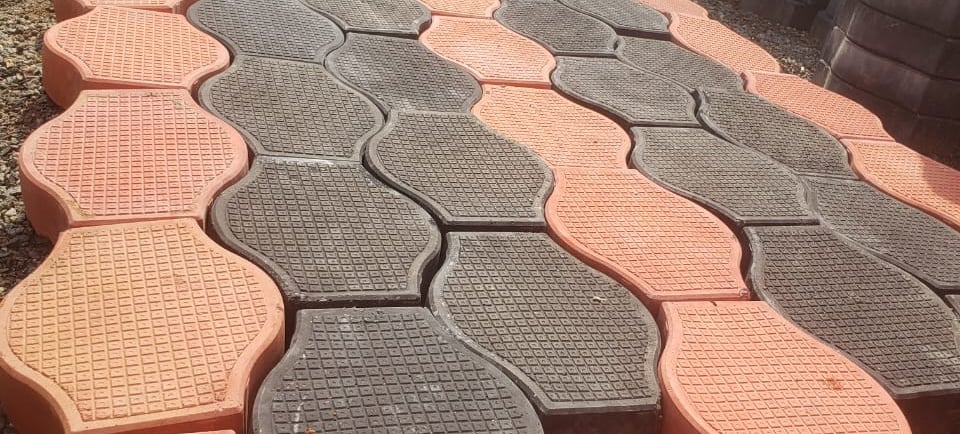

Table of Contents
Introduction
Importance of Estimating Materials
Materials Needed
Key Materials for Laying Pavers
Estimating Maram
Quantity and Calculation
Road Lime Calculation
Estimating Lake Sand
Road Cabs Calculation
Estimating Pavers
Kite and Rectangular Pavers
Plaster Sand Estimation
Concrete Bed Requirements
Cement, Sand, and Aggregates
Material Summary
Total Quantities Needed
Estimating the materials required to lay pavers is crucial for any construction project. It helps in budgeting, planning, and ensuring that you have the right amount of materials to complete the job efficiently. In this guide, we will break down the various materials needed, their quantities, and how to calculate them accurately for a given area. We will specifically focus on a site area of 447 square metres.
How to estimate material quantity required to lay pavers
Materials required for laying Pavers
When laying pavers, several key materials are required. Each of these materials serves a specific purpose in the overall construction process. Here’s a quick list of the major components you will need:
1.Murram
2.Road Lime
3.Lake Sand
4.Cement
5.Stone Dust
6.Plaster Sand
7.Pavers
Understanding the quantity of each material is essential for effective project management. Let’s delve into each material and how to calculate the required amount, assuming we have a 447 square meter area.
Estimating Marrum

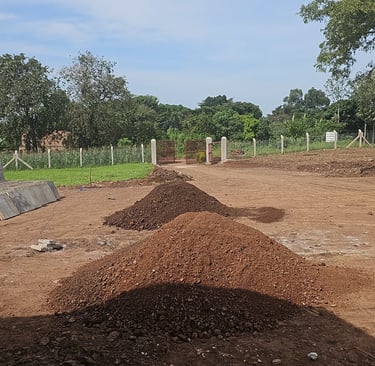
Maram serves as the foundational layer for the pavers. To estimate the quantity of maram required, we need to know the area it covers. A single FWD truckload of maram typically weighs 4 tons and can cover approximately 70 square metres. For our area of 447 square metres, the calculation is as follows:
Murram Required = Total Area / Area Covered by One Truck
Using the numbers:
447 m² / 70 m² = 6.4 trucks
Since we cannot have a fraction of a truck, we round up to 7 trucks. In terms of weight, this translates to:
7 trucks x 4 tons per truck = 28 tons of murram
Calculating Road Lime

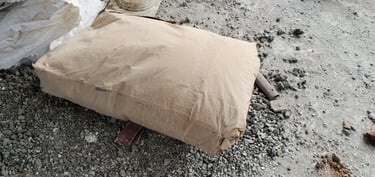
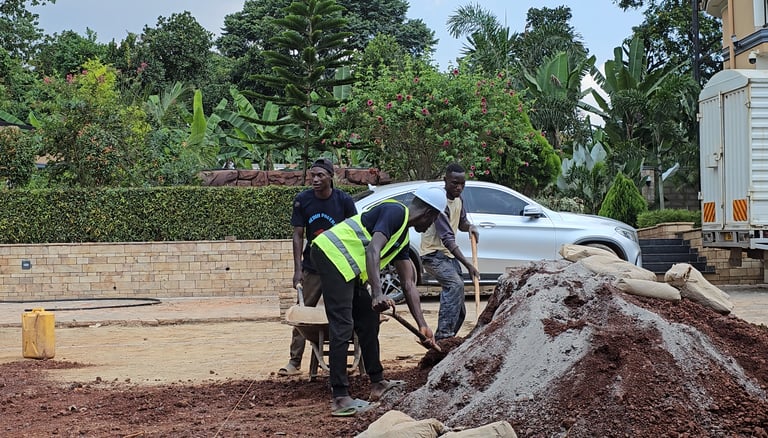

Next, we need to estimate the quantity of road lime. Road lime is mixed with maram to strengthen the base and prevent grass growth. The standard ratio is seven bags of road lime for each truck of murram. Therefore, for our 7 trucks of maram, we need:
Road Lime Required = Number of Trucks x Bags per Truck
7 trucks x 7 bags/truck = 49 bags of road lime
Each bag of road lime weighs 7 kg, making the total weight:
49 bags x 7 kg/bag = 343 kg of road lime
Estimating Lake Sand
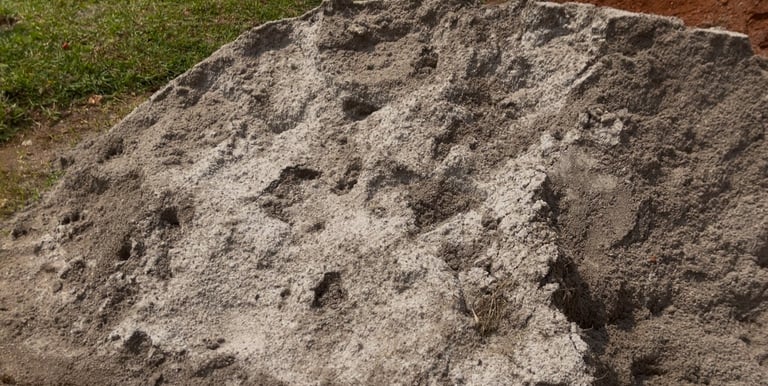

Lake sand is another important material, used to create a smooth surface for the pavers. One truckload of lake sand weighs 4 tons and covers about 80 square metres. To find out how much lake sand we need for our area, we perform the following calculation:
Lake Sand Required = Total Area / Area Covered by One Truck
447 m² / 80 m² = 5.64 trucks
Rounding up, we need 6 trucks of lake sand, which gives us:
6 trucks x 4 tons/truck = 24 tons of lake sand
Finding out the Number of Road kerbs

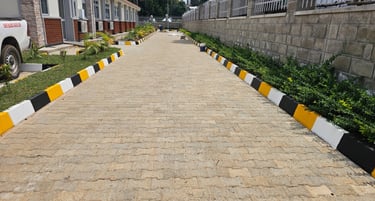
Road kerbs are essential for outlining the perimeter of the area where pavers will be laid; for example, the ones shown in the picture above painted black, yellow and white colours For every running meter, we require two road kerbs considering that each road kerb is half a metre. The total perimeter of our site is calculated as follows:
For a site with dimensions of 27.1 m, 18 m, and 27.4 m, plus additional lengths of 4 m on each side, the total perimeter is:
Total Perimeter = 27.1 + 18 + 27.4 + 4 + 4 = 80.5 m
Now, multiplying the perimeter by the number of road kerbs needed per meter gives us:
80.5 m x 2 = 161 road kerbs
Finding out the Number of Pavers Required
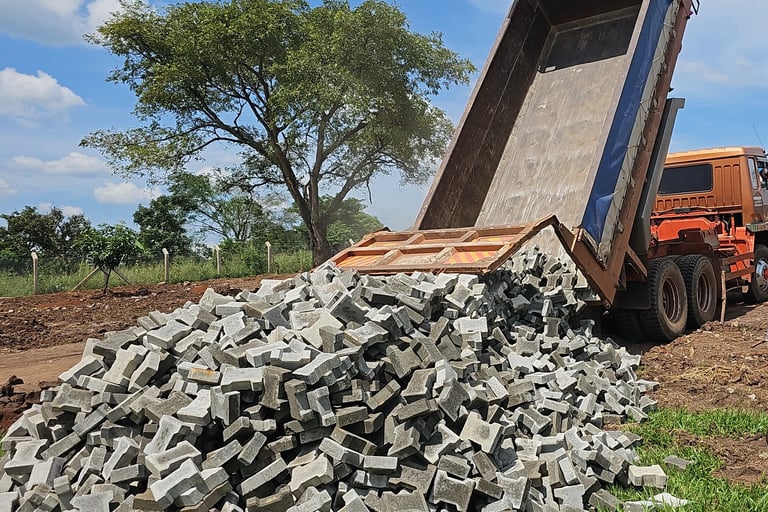



Pavers are the main required material for our project. For kite-shaped pavers, there are typically 30 pavers per square metre; for rectangular pavers, there are 50 pavers per square metre. Therefore, for our area of 447 square meters:
Pavers Required = Area x Pavers per Square Metre
considering that we use kite pavers, like the ones in the image below
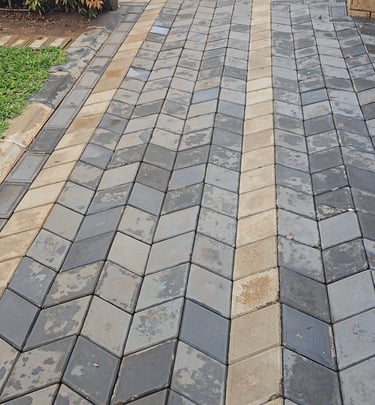

447 m² x 30 pavers/m² = 13,410 kite pavers
In addition to kite pavers, we also need rectangular pavers for the perimeter and around any manholes. For every running meter of the perimeter, we need 10 rectangular pavers. Therefore:
80.5 m x 10 = 805 rectangular pavers
Assuming we have 10 manholes, each with a perimeter of 4 m, we will require:
10 manholes x 40 pavers/manhole = 400 rectangular pavers
Adding an allowance of 45 rectangular pavers brings our total to:
13,410 + 805 + 400 + 45 = 14,660 pavers
Estimating Plaster Sand
Plaster sand is used to fill the joints between the pavers. One truckload of plaster sand can cover approximately 450 square meters. For our area:
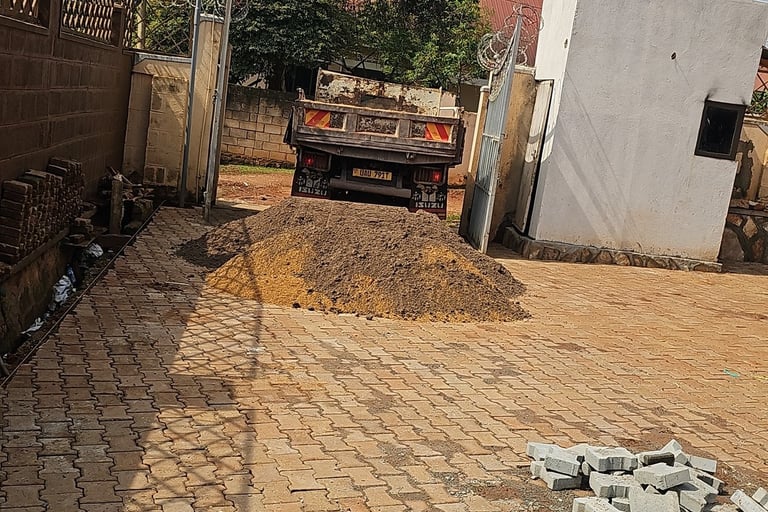

Plaster Sand Required = Total Area / Area Covered by One Truck
447 m² / 450 m² = 0.99 trucks
This means we only need 1 truckload, which is:
1 truck x 4 tons/truck = 4 tons of plaster sand
Cement, Sand, and Aggregates for Concrete Bed
To set the road cabs in place, we need to create a concrete bed. The mix ratio for concrete is typically 1:2:4 (Cement:Sand:Aggregate). For every cubic meter of concrete, the requirements are:
6.6 bags of cement
0.5 tons of sand
1.3 tons of aggregates
For a concrete bed measuring 80.5 m in length, 0.2 m in width, and 0.05 m in depth, the volume calculation is as follows:
Volume = Length x Width x Depth
Volume = 80.5 m x 0.2 m x 0.05 m = 0.8 m³
Now, applying the mix ratio to find the total quantities needed:
Cement: 0.8 m³ x 6.6 bags/m³ = 5.28 bags of cement
Sand: 0.8 m³ x 0.5 tons/m³ = 0.4 tons of sand
Aggregates: 0.8 m³ x 1.3 tons/m³ = 1.04 tons of aggregates
Summary of Material Requirements
To summarise, here are the quantities of materials required for laying pavers on a 447 square meter area:
Murram: 28 tons
Road Lime: 49 bags (343 kg)
Lake Sand: 24 tons
Road kerbs: 161 units
Kite Pavers: 13,410 units
Rectangular Pavers: 1,250 units (including allowances)
Plaster Sand: 4 tons
Cement: 5.28 bags
Sand: 0.4 tons
Aggregates: 1.04 tons
By following these calculations, you can ensure that you have the right quantity of materials to successfully complete your paving project. Proper estimation leads to better resource management and a smoother construction process.
We hope this guide provides valuable insights into estimating material quantities for laying pavers. If you found this information helpful, please consider sharing it with others who might benefit from it.